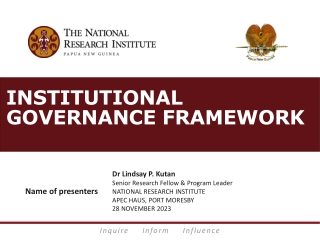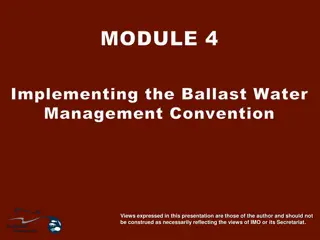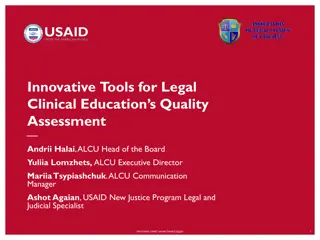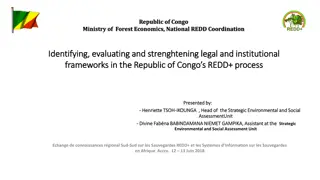
Insights into Agricultural Census Legislation and Frameworks
Discover the legal and institutional frameworks underlying agricultural censuses, including the legislative components, regulatory authorities, and key features such as scope, confidentiality, and data dissemination. Gain valuable insights into the global landscape of agricultural census practices and enforcement.
Download Presentation

Please find below an Image/Link to download the presentation.
The content on the website is provided AS IS for your information and personal use only. It may not be sold, licensed, or shared on other websites without obtaining consent from the author. If you encounter any issues during the download, it is possible that the publisher has removed the file from their server.
You are allowed to download the files provided on this website for personal or commercial use, subject to the condition that they are used lawfully. All files are the property of their respective owners.
The content on the website is provided AS IS for your information and personal use only. It may not be sold, licensed, or shared on other websites without obtaining consent from the author.
E N D
Presentation Transcript
Regional Roundtable on World Programme for the Census of Agriculture 2020 Port of Spain, Trinidad and Tobago 22-26 May 2017 Legal and Institutional frameworks Technical Session 17 Oleg Cara Agricultural Censuses and Surveys Team FAO Statistics Division (ESS) 1
CONTENTS Census legislation within the national legal framework Main features legislation Ensuring political conducting a census Census executing authority Coordinating boards Country examples of the census support for 2
Census legislation within the national legal framework (1) The agricultural census (AC) legislation exists within overall national legal and administrative frameworks. The census legal framework commonly consists of: Basic or primary legislation (or Principal Act , such as Act of Parliament , etc.) enacted by a legislature or other governing body; and Secondary legislation (also referred to as delegated legislation , subordinate legislation or subsidiary legislation ), made by an executive authority (such as the Cabinet of Ministers, the ministry of agriculture, etc.) under powers delegated by primary legislation. Census legal framework may be based on : The primary legislation of general nature, such as governing all official statistical activities in the country ( statistics law ) or the law establishing the Ministry of Agriculture, or other institution with the explicit mandate for the agricultural censuses. Specific agricultural census laws; such a census law may prescribe the conduct of censuses on a regular basis or may be set up before each agricultural census. The Law (Act) on Agricultural Statistics (e.g. in Germany, United Kingdom, etc.) or by the Law on Agriculture (Switzerland). 3
Census legislation within the national legal framework (2) General law or detailed legislation: Countries differ with respect to the degree of detail in their primary census legislation. Both general and detailed census laws offer benefits and have drawbacks. Broadly speaking, the general pattern followed in census legislation is for a Principal Act: o to authorise census taking, o to designate the census executing authority (or census agency ), o to state general provisions about the census implementation and o to empower the Cabinet (i.e. government) or a governmental organisation, such as a ministry, to prescribe rules where otherwise a time-consuming parliamentary procedure would be needed. Compliance of census legislation with Fundamental Principles of Official Statistics (FPOS): A census of agriculture as a statistical operation for collecting, processing and disseminating data on the structure of agriculture is an integral part of the national system of official statistics in a country. The census of agriculture should fully encompass the FPOS. 4
Main features of the census legislation Scope and coverage of the census Responsibility for the census Frequency of the census and time reference Administrative and financial provisions Rights and obligations of the public with respect to the census Confidentiality of information Identification, obligations and rights of enumerators and other census personnel Access to administrative data sources Census data dissemination Sanctions 5
Ensuring political support for conducting a census Like in a population census, in an agricultural census the combination of three factors makes managing a census challenging: It is one of the largest statistical activities in a country It is conducted only periodically, generally with a frequency of 10 years It involves the mobilization of important financial, human and other resources during a short period. A strong political support and establishing an efficient coordination between the census agency and other agencies is essential. 6
Census executing authority (1) The Census agency should be clearly specified in the primary census legislation. The administrative authority and responsibility to conduct agricultural censuses may be: Delegated to a specific government institution, such as: National Statistics Office (NSO) Ministry of Agriculture (MoA) or other executive branch of the government charged with agriculture. Under the joined responsibility of NSO and MoA and possibly may involve other ministries governments. and agencies, and/or local 7
Census executing authority (2) The Census Office (CO): Has the primary and chief responsibility for planning, organizing, conducting and supervising the agricultural census operations, including developing the methodology and all technical documentation, data collection, data processing, analysis, archiving and dissemination census results. Commonly is established within the census agency on a permanent basis or just for the period of preparation to the census until its finalisation. The number of census personnel is adjusted to meet the needs at different stages of census operation. The role of the census coordinator, who is usually the head of the CO, is important to ensure a successful census programme that delivers results for the users. Often the CO consists of: Central office & Provincial/district offices (COs at sub national level). of 8
Example of structure of a census organization Central Government Institutions Census Steering Committee Census Agency Other Stakeholders and Users Central Census office Census Subcommittees Working Groups Provincial Census Offices Provincial Census Committees District Census Committees District Census Offices 9
Coordinating boards (1) Technical Steering Committee (TSC): o It is aimed at coordination of technical aspects of census preparation and implementation. o Generally, the main responsibility would be the overall planning and direction of the census, subject to review by the census coordinator. o It could endorse the census work plan, scope and coverage, main methodological principles, questionnaires, manuals, budgetary and personnel requirements, plans for the publicity campaign, logistical needs, pre-test and pilot censuses, post-enumeration survey plan. o Should consist of representatives of major stakeholders, who are able to provide high- level specialist advice and are in a position to take decisions on behalf of the institutions they represent. o May be created by the regulatory text establishing the census. o The committee s chairperson could be the head of the census agency or another person appointed by him/her. o Should start functioning at least two years ahead of the actual operations of the field work of the census and cease to function after the dissemination of the final census reports and archiving of the census data. 10
Coordinating boards (2) National High-level Steering Committee (NSC): Main tasks: provide support to the census agency in setting up a good collaboration with relevant ministries/public agencies at the national and sub national levels to get their necessary support and necessary human, financial, technical and other resources for the adequate preparation and conduct of census operations, ensure a large public support through a promotion of a wide census publicity campaign. o Chaired by a high-ranking official in the government and its members are high level representatives from ministries and other public agencies, as well as from non-governmental organizations, businesses and academia. o Useful especially in countries with little experience in agricultural census taking, a decentralized agricultural statistics system or/and lacking a well- established coordination mechanism programme. o of agricultural statistics survey 11
Coordinating boards (3) Sub-committees, advisory and working groups: o May be created, each under the area of coordination or supervision of a member of the TSC or NSC. o Can be formed to advise on specific technical matters (such as concepts and definitions, methodological aspects, questionnaire design, data processing, etc.), or on more general aspects of the census operation (such as communications, transportation, logistics, recruitment, training, publicity, data dissemination, etc.). o Would normally consist of a small group of subject matter specialists and would report on a regular basis to the TSC/NSC. Advisory boards: o May be created to advise the CO on strategic issues or particular technical aspects of census operation. o Their members could be experts on agriculture, agricultural statistics, sample design, information technology, representatives of important users segments, such as those involved in analytical studies of the agricultural and rural development of the country, etc. o The most use should be made in the planning and preparation phases and not in the operational phases. 12
Coordinating boards (4) Provincial committees: o Main functions: to coordinate the activities of different institutions contributing to census implementation at the provincial level. o May be established especially in large countries, in broad administrative divisions. o Could be asked by the census agency to make recommendations for items specific to the province to be included in census questionnaires and to advise on provincial tabulations. o Their activity would normally be coordinated by the steering committee (TSC or NSC) and should be carried out in close cooperation with the provincial census office. o Usually the head of provincial census office act as a secretary of a provincial committee. o In some countries, census committees are also set up at district and at a lower administrative level. 13
Country examples Saint Lucia: Agricultural Census 2007 The 2007 Census of Agriculture was conducted in accordance with the Statistical Act No 13. of 1973. The Act provides for the collection, compilation and analysis of certain statistical information including the taking of census and the publication of that information In Section 3, the Act prescribes the duties of the Central Statistical Office (CSO) and the first listed duty is to take any census in the Island . In Section 4, the Act establishes that the Statistician may delegate in writing his powers and functions under thisAct . For the St Lucia Census of Agriculture 2007 such delegation was done by means of a 2007 Censal Decree approved by the Cabinet of Ministers that appointed the Corporate Planning Unit of the Ministry of Agriculture, Forestry and Fisheries as the Office in charge in collaboration with the CSO. 14
Country examples(2) Saint Lucia: Agricultural Census 2007 The 2007 Censal Decree established the following: i) the year of census taking ii) the reference year iii) the main objectives of the census iv) the main data to be collected v) the coverage vi) the office responsible for taking the census vii) the official appointment of the National Census Advisory Committee and viii) the specific provisions of the Statistical Act 1973 applied to the census. The National Census Advisory Committee included 18 members from the Ministry ofAgriculture, CSO and producers associations. 15
Country examples(3) Saint Lucia: Agricultural Census 2007 The 2007 Census of Agriculture was organized according to the following Organization chart (source: 2007 St. Lucia Census of Agriculture Final Report): 16
THANK YOU 17






















